Characteristics of Recent and Established EEA and non-EEA migrants in Scotland: Analysis of the 2011 Census
This report presents findings from analysis of the 2011 Census on characteristics and experiences of recent and established migrants from EEA and non-EEA countries living in Scotland.
4. Education and employment
Educational qualifications
Half (49 per cent) of all migrants aged 16 and above had at least degree level qualifications. This compares to a quarter (26 per cent) of the population as a whole[9].
People from the recent non-EEA migrant group were most likely to be educated to 'degree level' (60 per cent). This likely reflects the relatively large proportion of students in this group (see Chart 4.3).
Around a quarter of established EEA and established non-EEA migrants reported having no qualifications. The equivalent proportion of recent migrants with no qualifications was lower at around 10 per cent. The proportion of the Scottish population as a whole with no qualifications was higher at 27 per cent[10].
Chart 4.1. Educational qualifications, all migrants aged 16 and above
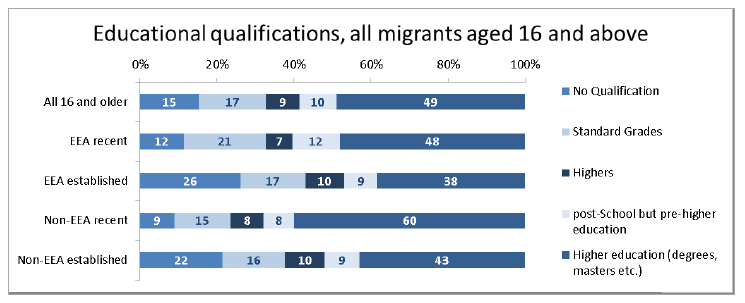
Source: 2011 Census, National Records of Scotland; Note: These include foreign qualifications.
Economic activity
When comparing those migrants aged 16 to 74 who were economically active and those who were inactive, Chart 4.2 shows that the proportion economically active was largest amongst recent EEA migrants (78 per cent) and lowest amongst recent non-EEA migrants (58 per cent). Established EEA and non-EEA migrants had similar proportions of people who were economically active (70 and 71 per cent respectively). 69 per cent of the Scottish population as a whole were economically active[11].
Chart 4.2. Economic activity, all migrants aged 16 to 74 (including students).
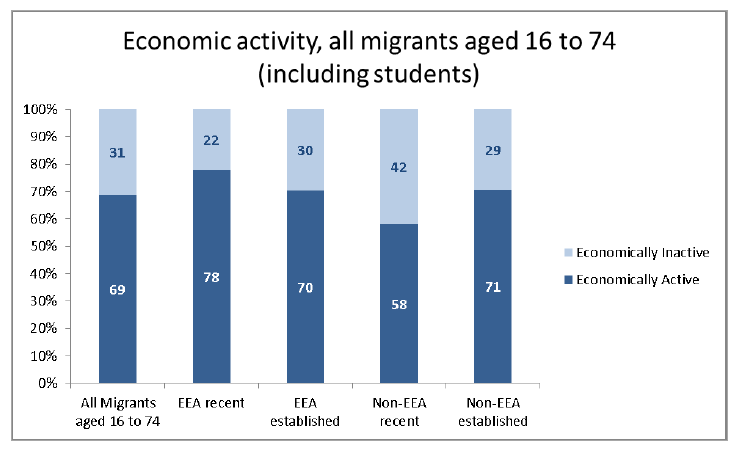
Source: 2011 Census, National Records of Scotland
Examining the type of activity of those who were economically active, Chart 4.3 shows that the proportion of people working part-time was similar across migrant groups, with between 14 and 16 per cent working part-time. The recent EEA migrant group had the largest proportion of people working full-time, at 50 per cent.
Established migrants were the most likely to be self-employed, with 10 per cent of EEA migrants and 14 per cent of non-EEA migrants being self-employed. Migrants from the recent non-EEA group were the most likely to be unemployed (8 per cent).
When examining the type of inactivity of migrants who were economically inactive, Chart 4.3 shows that 16 per cent of established EEA migrants were 'retired', and equal proportions were 'students', 'looking after the home or family' or 'long-term sick or disabled' (all 4 per cent).
Compared to established EEA migrants, a smaller proportion of established non-EEA migrants were retired (11 per cent) and a larger proportion were 'looking after the home and family' (7 per cent). The proportions of retired and 'long-term sick or disabled' may be associated with the older age profile of the established migrant groups (see also next section on health).
With a younger age profile overall, the majority of recent EEA migrants and recent non-EEA migrants who were economically inactive were so because they were students (15 and 29 per cent respectively). Almost twice the proportion of recent non-EEA migrants (7 per cent) were 'looking after the home or family' compared to recent EEA migrants (4 per cent).
Chart 4.3. Economically activity and inactivity detail, all migrants aged 16 to 74
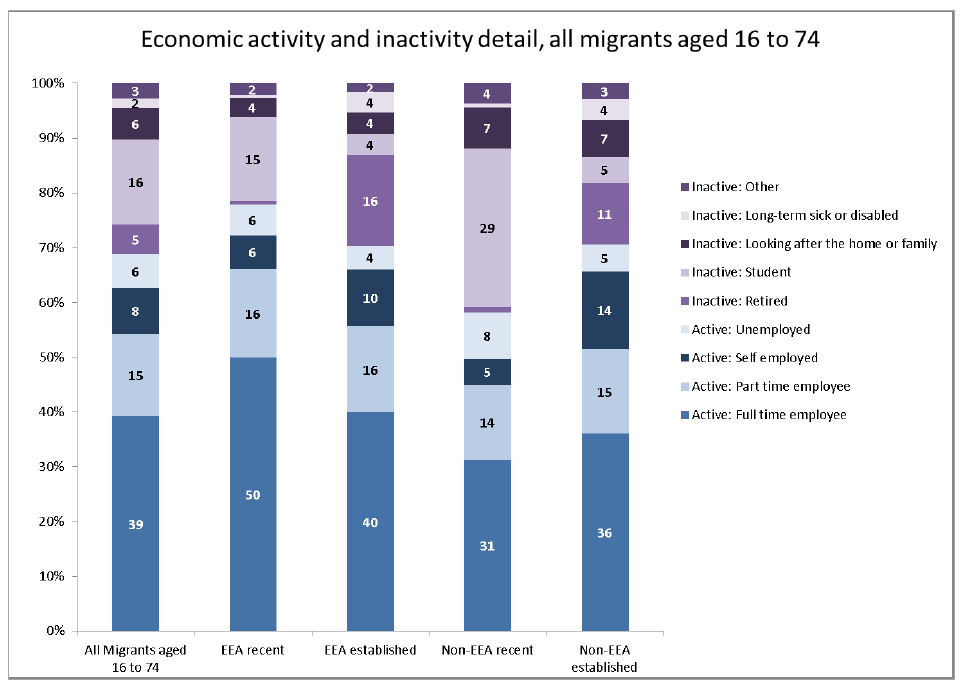
Source: 2011 Census, National Records of ScotlandSector of employment
Recent EEA migrants, aged 16 to 74 and in employment, were more likely to work in manufacturing (17 per cent) than other migrant groups. The most common sector of employment for recent EEA migrants in employment, at 19 per cent, was 'Accommodation and food service activities'. See Table 4.1.
One in six (16 per cent) established EEA migrants and established non-EEA migrants worked in 'Human health and social work' sectors. For recent non-EEA migrants, this was the most common sector of work at 20 per cent. A further 12 and 11 per cent of established EEA and non-EEA migrants worked in the Education sector.
Recent non-EEA migrants were less likely to work in the Construction industry (2 per cent) compared to those in the other migrant groups.
Table 4.1 Employment sector, all migrants aged 16 to 74 in employment, percentages
|
|
All 16 to 74 in employment |
EEA recent |
EEA established |
Non-EEA recent |
Non-EEA established |
|---|---|---|---|---|---|
| Agriculture, Forestry, Fishing; Electricity, Gas, Mining; Water Supply, Waste Management (A, B, D, E) |
4 |
5 |
4 |
4 |
3 |
| Manufacturing (C) |
9 |
17 |
6 |
4 |
5 |
| Construction (F) |
4 |
6 |
5 |
2 |
4 |
| Wholesale and retail trade; repair of motor vehicles and motorcycles (G) |
13 |
11 |
12 |
13 |
15 |
| Transport and storage (H) |
4 |
4 |
4 |
3 |
4 |
| Accommodation and food service activities (I) |
15 |
19 |
9 |
15 |
14 |
| Information and communication (J) |
3 |
2 |
4 |
5 |
3 |
| Financial and insurance activities (K) |
4 |
2 |
4 |
6 |
4 |
| Real estate activities (L) |
1 |
1 |
1 |
1 |
1 |
| Professional, scientific and technical activities (M) |
6 |
4 |
7 |
7 |
7 |
| Administrative and support service activities (N) |
6 |
8 |
4 |
5 |
3 |
| Public administration and defence (O) |
3 |
2 |
6 |
3 |
5 |
| Education (P) |
9 |
6 |
12 |
9 |
11 |
| Human health and social work (Q) |
14 |
8 |
16 |
20 |
16 |
| Arts; Entertainment and recreation; Other (R,S,T,U) |
5 |
4 |
5 |
4 |
5 |
Source: 2011 Census National Records of Scotland.
Classification is based on the Standard Industrial Classification, 2007, letters indicate classification.
Occupation
Recent EEA migrants were the least likely to work in Professional Occupations (13 per cent) and Associate Professional and Technical Occupations (7 per cent). They were most likely to work in 'Skilled Trade' (14 per cent), 'Process' (12 per cent) and 'Elementary Occupations' (30 per cent). See Table 4.2.
In contrast, recent non-EEA migrants were more likely than other migrant groups to work in Professional Occupations (29 per cent). Established EEA (11 per cent) and established non-EEA (14 per cent) migrants were proportionally more likely to be represented in the 'Managers, Directors and Senior Officials' occupational sector.
Fifteen percent of recent non-EEA migrants were working in Elementary Occupations, half as many as recent EEA migrants.
Table 4.2. Occupation, all migrants aged 16 to 74 in employment, percentages
|
|
All 16 to 74 years in employment |
EEA recent |
EEA established |
Non-EEA recent |
Non-EEA established |
|---|---|---|---|---|---|
| Managers, Directors and Senior Officials |
8 |
4 |
11 |
6 |
14 |
| Professional Occupations |
22 |
13 |
25 |
29 |
26 |
| Associate Professional and Technical Occupations |
10 |
7 |
14 |
11 |
13 |
| Administrative and Secretarial Occupations |
7 |
5 |
9 |
7 |
9 |
| Skilled Trade Occupations |
11 |
14 |
10 |
8 |
11 |
| Caring, Leisure and other Service Occupations |
9 |
8 |
9 |
11 |
7 |
| Sales and Customer Service Occupations |
7 |
6 |
8 |
10 |
8 |
| Process, Plant and Machine Operatives |
7 |
12 |
5 |
3 |
4 |
| Elementary Occupations |
18 |
30 |
9 |
15 |
8 |
Source: 2011 Census, National Records of Scotland
Classification is based on the Standard Occupational Classification, 2010.
Hours worked
Around 70 per cent of migrants who were in employment, worked full-time, compared to 72 per cent of the population as a whole who work full-time[12]. Established EEA and established non-EEA migrants worked the longest hours with 15 per cent and 16 per cent respectively reporting to work 49 hours or more. People from different migrant groups who were working part-time worked a similar number of hours. See Chart 4.4.
Chart 4.4. Hours worked, all migrants aged 16 to 74 years in employment
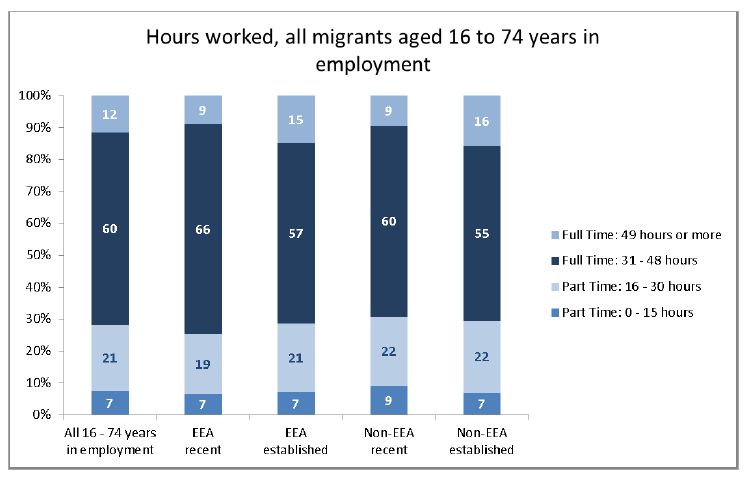
Source: 2011 Census, National Records of Scotland
Socio-economic classification
The National Statistics Socio-economic Classification (NS-SeC) provides an indication of socio-economic position based on occupation and employment status. Full-time students were classed as 'full-time students', irrespective of whether they were economically active or not.
NS-SeC shows that established EEA and established non-EEA migrants were proportionally more concentrated in both lower and higher managerial and professional occupations than recent migrants.
Almost two in five (38 per cent) recent non-EEA migrants were full time students, compared to a quarter (24 per cent) of recent EEA migrants. Seven per cent of both established EEA and established non-EEA migrants were full-time students, compared to 9 per cent of the Scottish population as a whole[13].
The largest proportion of people in routine and semi-routine occupations were from the recent EEA group. They were more than twice as likely (37 per cent) to be in routine or semi-routine occupations than recent non-EEA migrants (15 per cent).
Chart 4.5. NS-SeC, all migrants 16 to 74
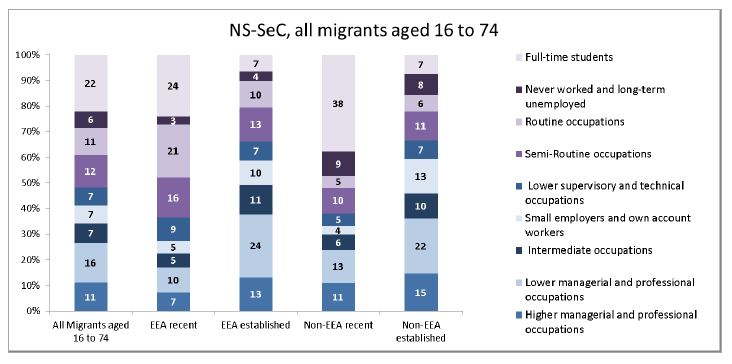
Source: 2011 Census, National Records of Scotland
Socio-economic status and educational qualifications
In order to explore whether their socio-economic classification reflects their education level, the association between these characteristics was examined more closely for those migrants with degree level qualifications.
Chart 4.6 presents the highest and lowest NS-SeC classifications for migrants with degree level qualifications only, and excludes those who were full time students. Over half (55 per cent) of migrants with degree level qualifications were classified as being in managerial and professional occupations. This varied from 38 per cent of recent EEA migrants to 70 per cent of established EEA migrants.
Recent EEA migrants were also more likely than other migrants to be classified in routine (18 per cent) and semi-routine (17 per cent) occupations, despite having degree level qualifications.
Chart 4.6. NS-SeC, migrants aged 16 to 74 with degree level qualifications, excluding full time students
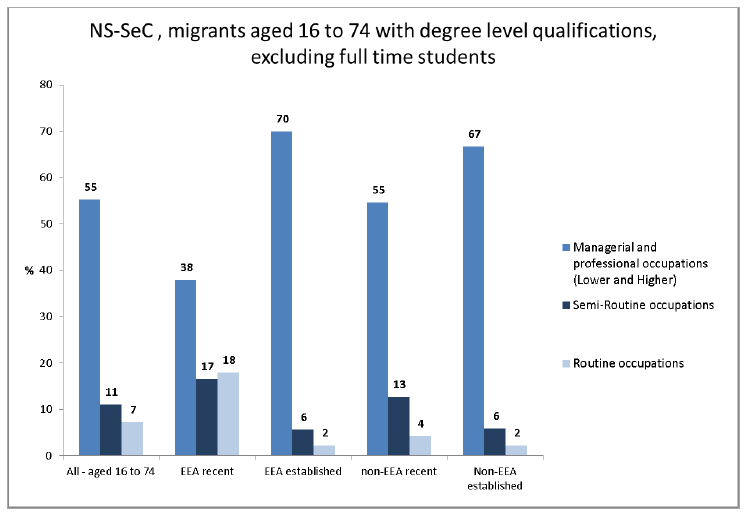
Source: 2011 Census, National Records of Scotland
Contact
Email: Wendy van Rijswijk
There is a problem
Thanks for your feedback